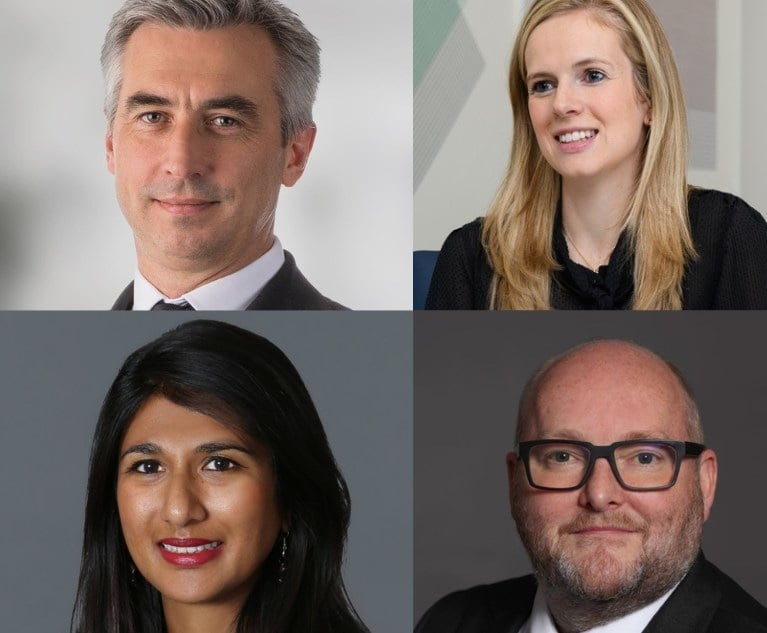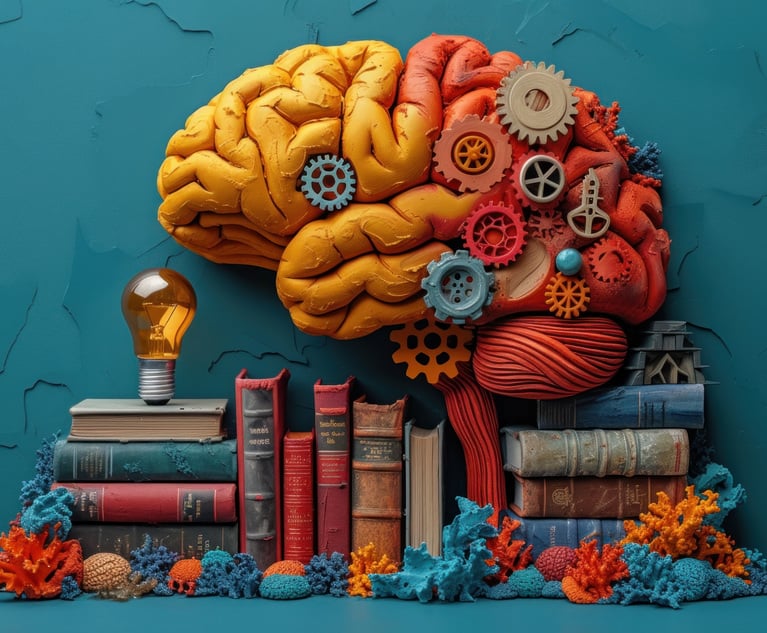GC Diversity Mandates Had a Soft Launch—Now They're Serious
General counsel's push for diversity hasn't moved the needle yet, but it may soon kick into high gear.
May 29, 2018 at 12:01 AM
11 minute read

Last year, general counsel of major U.S. corporations issued a strong mandate to their outside counsel. Give us diverse teams of attorneys, they said, or else. While such strategies had been implemented before by clients, this time the request took a much more serious tone that threatened to affect firms' bottom lines.
General counsel at Hewlett-Packard, Facebook Inc. and Metropolitan Life Insurance Co. announced initiatives in early 2017 that required more diversity among their outside counsel at the risk of decreased fees.
In the year since these mandates, Big Law has worked to meet the new demands, crafting and implementing diversity and inclusion initiatives that strive to increase the recruitment of diverse talent and develop opportunities for minorities to rise through the ranks.
General counsel have used this year as a training ground to prepare law firms for the expectations ahead—and now they're ready to get serious.
There is still a long road ahead for Big Law, as the results of our 2018 Diversity Scorecard show. The proportion of minorities in Big Law still continues to increase incrementally.
Minority lawyers working in Am Law 200 firms and NLJ 250 firms increased just 0.5 percent in 2017, making up only 16.1 percent of attorneys in Big Law, up from 15.6 percent in 2016. The percentage of minority partners also saw 0.5 percent growth in 2017, to 9.1 percent from 8.6 percent the year prior. The total number of minority nonpartners at law firms inched up to 21.7 percent from 21.2 percent in 2016.
The slight increase in the number of diverse attorneys in Big Law was mirrored among the different minority groups in this year's Diversity Scorecard. Asian-American lawyers still remain the best-represented group, comprising 7.1 percent of Big Law attorneys in 2017, up from 6.9 percent the year prior. The proportion of Asian-American partners increased 0.2 percent from 2016 to 3.5 percent last year while nonpartners only increased 0.1 percent across Big Law to 10 percent.
The total number of African-American attorneys only increased from 3 percent to 3.1 percent last year. Likewise, the number of African-American partners and nonpartners only increased 0.1 percent to 2 percent and 4.1 percent, respectively.
The total number of Hispanic attorneys also grew 0.1 percent to 3.8 percent in 2017. The same went for increases among partner and nonpartner ranks, which grew to 2.7 percent and 4.6 percent, respectively.
For the fifth consecutive year, White & Case holds the top spot on the Diversity Scorecard rankings. (Each law firm earned a score that is based on its percentage of minority lawyers plus its percentage of minority partners.) Of the firm's 717 attorneys in the United States in 2017, 33.8 percent were minorities, including 21 percent of U.S. partners. These percentages are up slightly from 2016, when the firm reported that 33.4 percent of its attorneys and 20.6 percent of its partners belonged to a minority group.
“Our commitment to a diverse and inclusive workplace is absolute,” says Maja Hazell, global head of diversity and inclusion at White & Case.
“In addition to a number of affinity groups, initiatives and projects dedicated to increasing diversity and fostering more inclusive leadership competencies, we value education and growing understanding of our people's varied backgrounds, interests and needs in order to deliver their best performance,” she adds.
Fragomen, Del Rey, Bernsen & Loewy, a New York-based firm that focuses on immigration law, held the second spot on the Scorecard for the fourth year in a row. Wilson Sonsini Goodrich & Rosati and Fenwick & West again ranked third and fourth, respectively, while Best Best & Krieger jumped from No. 12 to the fifth spot on the scorecard.
Procopio, Cory, Hargreaves & Savitch; Morrison & Foerster; Curtis, Mallet-Prevost, Colt & Mosle; Kobre & Kim; and Cleary Gottlieb Steen & Hamilton rounded out the top 10 firms.
Further down the scorecard, several firms made notable gains in diversity. Kramer Levin Naftalis & Frankel made the largest leap in 2017, jumping from No. 124 to No. 79, thanks to a slight increase in the number of Asian-American nonpartners and partners.
Reed Smith jumped up the rankings from No. 120 to No. 82, due in part to increases in its Hispanic head count. Hughes Hubbard & Reed also had one of the biggest jumps in 2017, moving from No. 74 to No. 41, while California-based Allen Matkins Leck Gamble Mallory & Natsis also bumped up from No. 81 to No. 45, thanks to some additions in its Asian-American head count.
Where there's growth, there's also decline. Schiff Hardin had the steepest drop in 2017, falling from No. 60 to No. 112. The firm's percentage of minority attorneys fell from 16.4 in 2016 to 13.7 last year due to significant drops in the number of Asian-American nonpartners, African-American partners and Hispanic partners.
“We saw a modest 3 percent drop in our minority lawyer count, which is a trend we want to reverse because diversity has always been a strong tradition and a key component of Schiff Hardin's culture,” says Schiff Hardin managing partner Marci Eisenstein. “We remain committed to recruiting and retaining top diverse talent.”
Greenspoon Marder also had one of the largest drops in 2017, falling from No. 46 to No. 85. Dickinson Wright fell from No. 142 to No. 179 due to a 3.4 percent decrease in the number of minority attorneys across its offices in the United States.
A Mandate for Change
In February 2017, Kim Rivera, chief legal officer and general counsel at HP, caught the attention of the legal community when she and HP announced a new diversity initiative that required its outside firms to have at least one diverse relationship partner on its matters or have one woman and “racially/ethnically diverse attorney” performing at least 10 percent of the billable hours.
Since then, Rivera and her team have been tracking hours submitted by their outside counsel and have looked at hours recorded by diverse attorneys on a quarterly basis, using a tool that both collects the data and automates it to determine whether firms are meeting the criteria, Rivera says.
And so far, the feedback from law firms has been quite positive.
“Firms have been overwhelmingly supportive of the initiative, and many have specifically expressed the desire to help ensure its success,” Rivera says. “We've heard from multiple firms that our initiative is providing the impetus to drive broader change within their own organizations.”
Over the course of the mandate's pilot year, HP solicited information and reported the results but withheld no fees, Rivera says. That allowed the company to proactively identify and address any gaps or issues in its requirements or concerns over technology used to collect the information.
Not everything has been rosy.
“Although we have offered guidance and support during the ramp-up period, a handful of firms were not compliant with the initiative and we have already started withholding from invoices submitted,” Rivera says.
She doesn't believe that any of these firms “aren't getting it,” though. Rather, Rivera and her HP team understand that for some firms it will take longer to implement structures that enable them to meet the company's criteria.
“We are working with these firms to understand their barriers and how we can help them overcome them,” she says. “Working together, we believe we can enable the systemic change we are striving for.”
New Approaches, New Opportunities
While diversity mandates like those issued by general counsel last year aren't anything new, there has been a higher level of intensity around these issues of late, says Carlos Dávila-Caballero, director of diversity and inclusion at Cleary.
Before these diversity mandates, when clients requested metrics from law firms around diversity and inclusion, it was often through a diversity supplier program, Dávila-Caballero says.
For example, he says, “the corporation had diversity supplier mandates and that team would send us a communication and we would respond to it and that would be the end of that endeavor and you would not hear back.”
Even though corporations are still collecting the same information, they aren't doing it from the diversity supplier side. Instead, many requests have now come straight from general counsel offices, which creates a different set of communications and evaluations, Dávila-Caballero says.
“That means that I [and] the relationship partners at the firm are receiving email communications, telephone conversations, invitations to sit and discuss the staffing,” he says.
And for a firm such as Cleary, where nearly 29 percent of attorneys are diverse, that means talking about best practices the firm has implemented and how companies can implement them in their own legal teams.
This has resulted in a variety of collaborations between clients and their law firms, whether that's through diversity and inclusion programming and curricula on unconscious bias or mentoring, or through other endeavors.
“It really has opened the door, and it's now presenting an excellent opportunity for heads of diversity like myself [or] chief diversity officers to work with internal leadership and collaborate with the general counsel and the relationship partners on a whole series of topics that [were] very inward-looking and now become external,” Dávila-Caballero says. “And I think that will become a positive, and I think that is why we will start to see a lot more movement in it.”
PepsiCo Inc., which, like HP, has one of the highest shares of ethnic minorities on its board, at 27 percent, implemented one of the more stringent diversity surveys.
In addition to using the American Bar Association Model Diversity Survey, the beverage company's reporting requirement includes an essay question asking about the law firm's diversity recruitment and retention strategies and other specific attributes that would drive a more diverse culture, says Michele Thatcher, senior vice president and chief counsel at PepsiCo.
“It's just giving examples of things that they're doing,” Thatcher says. “Knowing that we care about those examples really seems to have been positive.”
The inclusion of an essay also allows PepsiCo to look beyond the numbers that law firms report.
“Whenever you have a statistical analysis or you have a formula, that formula or stat may not tell the whole picture,” says Dave Yawman, PepsiCo's executive vice president and general counsel. “And so the challenge is any time you're asking just for numbers, how do you flesh out the story of what's really going on at the firm.”
Yawman gives the example of a law firm that had four diverse partners leave over the course of the year for in-house positions. While the firm's statistics were impacted, it wanted to assure its client that its commitment to diversity and inclusion remained intact.
A Matter of Intent
At the end of the day, the profession as a whole has to be proactive, deliberate and persistent, Yawman says.
Law firms can't take a first-year associate and make that person a partner when they aren't ready, but firms have to have an intent and stick with it year in and year out, he adds.
“It's one of the things that we flesh out through our program, and through our discussions with firms, is no matter where anybody is relative to their scoring, whether they are above or below our median, we expect everybody, ultimately, to do a little better the next time that we ask,” Yawman says.
These discussions have also yielded conversations about perhaps the biggest and most persistent issue when it comes to tackling diversity in the legal profession: the pipeline.
“Some firms talked about the need to start at the high school level and start to drive diversity in terms of just getting diverse students interested in the law and helping them put their career plan through college and, ultimately, hopefully, matriculating on to law school,” Thatcher says.
While the number of diverse law students grows from year to year, it still hasn't grown to a huge number, and firms are often left fighting over a small number of students from the beginning, says Atif Khawaja, chair of Kirkland & Ellis' diversity and inclusion committee.
“What I think the industry as a whole needs to do, and something we at Kirkland are committed to achieving, is to make the practice of law more interesting and inclusive so a broader mix of people choose to participate in it,” Khawaja says.
Email: [email protected]
This content has been archived. It is available through our partners, LexisNexis® and Bloomberg Law.
To view this content, please continue to their sites.
Not a Lexis Subscriber?
Subscribe Now
Not a Bloomberg Law Subscriber?
Subscribe Now
NOT FOR REPRINT
© 2025 ALM Global, LLC, All Rights Reserved. Request academic re-use from www.copyright.com. All other uses, submit a request to [email protected]. For more information visit Asset & Logo Licensing.
You Might Like
View All

Trending Stories
Who Got The Work
J. Brugh Lower of Gibbons has entered an appearance for industrial equipment supplier Devco Corporation in a pending trademark infringement lawsuit. The suit, accusing the defendant of selling knock-off Graco products, was filed Dec. 18 in New Jersey District Court by Rivkin Radler on behalf of Graco Inc. and Graco Minnesota. The case, assigned to U.S. District Judge Zahid N. Quraishi, is 3:24-cv-11294, Graco Inc. et al v. Devco Corporation.
Who Got The Work
Rebecca Maller-Stein and Kent A. Yalowitz of Arnold & Porter Kaye Scholer have entered their appearances for Hanaco Venture Capital and its executives, Lior Prosor and David Frankel, in a pending securities lawsuit. The action, filed on Dec. 24 in New York Southern District Court by Zell, Aron & Co. on behalf of Goldeneye Advisors, accuses the defendants of negligently and fraudulently managing the plaintiff's $1 million investment. The case, assigned to U.S. District Judge Vernon S. Broderick, is 1:24-cv-09918, Goldeneye Advisors, LLC v. Hanaco Venture Capital, Ltd. et al.
Who Got The Work
Attorneys from A&O Shearman has stepped in as defense counsel for Toronto-Dominion Bank and other defendants in a pending securities class action. The suit, filed Dec. 11 in New York Southern District Court by Bleichmar Fonti & Auld, accuses the defendants of concealing the bank's 'pervasive' deficiencies in regards to its compliance with the Bank Secrecy Act and the quality of its anti-money laundering controls. The case, assigned to U.S. District Judge Arun Subramanian, is 1:24-cv-09445, Gonzalez v. The Toronto-Dominion Bank et al.
Who Got The Work
Crown Castle International, a Pennsylvania company providing shared communications infrastructure, has turned to Luke D. Wolf of Gordon Rees Scully Mansukhani to fend off a pending breach-of-contract lawsuit. The court action, filed Nov. 25 in Michigan Eastern District Court by Hooper Hathaway PC on behalf of The Town Residences LLC, accuses Crown Castle of failing to transfer approximately $30,000 in utility payments from T-Mobile in breach of a roof-top lease and assignment agreement. The case, assigned to U.S. District Judge Susan K. Declercq, is 2:24-cv-13131, The Town Residences LLC v. T-Mobile US, Inc. et al.
Who Got The Work
Wilfred P. Coronato and Daniel M. Schwartz of McCarter & English have stepped in as defense counsel to Electrolux Home Products Inc. in a pending product liability lawsuit. The court action, filed Nov. 26 in New York Eastern District Court by Poulos Lopiccolo PC and Nagel Rice LLP on behalf of David Stern, alleges that the defendant's refrigerators’ drawers and shelving repeatedly break and fall apart within months after purchase. The case, assigned to U.S. District Judge Joan M. Azrack, is 2:24-cv-08204, Stern v. Electrolux Home Products, Inc.
Featured Firms
Law Offices of Gary Martin Hays & Associates, P.C.
(470) 294-1674
Law Offices of Mark E. Salomone
(857) 444-6468
Smith & Hassler
(713) 739-1250












